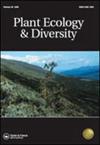亚马逊油棕榈景观中树木多样性和碳储量的异质性
IF 1.6
4区 生物学
Q2 PLANT SCIENCES
引用次数: 4
摘要
摘要背景:新热带地区大规模油棕扩张对生物多样性和碳储量的定量影响仍然缺乏文献记载。目的:我们评估了巴西帕拉州主要土地覆盖类型在树种组成和丰富度以及地上碳储量方面的差异。方法:对残留原始雨林、幼龄次生林、油棕人工林和牧场林分的树种组成、丰富度和地上碳储量进行量化。结果:我们对68科413种中的5696株DBH≥2cm的树木进行了采样,其中381种记录在原始森林碎片中。我们发现,四个土地覆盖类别之间的物种丰富度和碳储量存在显著差异。残余原始森林中的碳储量通常超过190 Mg ha−1,而其他土地覆盖类型中的碳存量通常低于60 Mg ha–1。结论:油棕榈人工林存在物种贫乏、管理积极的树种群落;古老的种植园的碳储量与次生林相当,远大于牧场。油棕榈公司控股的私人森林保护区在保护亚马逊地区人类改造景观中的原始森林树木多样性方面发挥着重要作用。本文章由计算机程序翻译,如有差异,请以英文原文为准。
Heterogeneity of tree diversity and carbon stocks in Amazonian oil palm landscapes
ABSTRACT Background: Quantitative effects of large-scale oil palm expansion in the Neotropics on biodiversity and carbon stocks are still poorly documented. Aims: We evaluated differences in tree species composition and richness, and above-ground carbon stocks among dominant land cover types in Pará state, Brazil. Methods: We quantified tree species composition and richness and above-ground carbon stock in stands in remnant primary rain forest, young secondary forest, oil palm plantation and pastures. Results: We sampled 5,696 trees with a DBH ≥ 2 cm, of 413 species in 68 families, of which 381 species were recorded in primary forest fragments. We found significant differences in species richness and carbon stock among the four land cover classes. Carbon stocks in remnant primary forest were typically over 190 Mg ha−1, while those in other land cover types were typically less than 60 Mg ha−1. Conclusion: Oil palm plantations have a species-poor tree community given active management; old plantations have a standing carbon stock which is comparable to that of secondary forest and far greater than that of pastures. Private forest reserves within oil palm company holdings play an important role in preserving primary forest tree diversity in human-modified landscapes in Amazonia.
求助全文
通过发布文献求助,成功后即可免费获取论文全文。
去求助
来源期刊

Plant Ecology & Diversity
PLANT SCIENCES-
CiteScore
3.30
自引率
0.00%
发文量
26
审稿时长
3 months
期刊介绍:
Plant Ecology and Diversity is an international journal for communicating results and novel ideas in plant science, in print and on-line, six times a year. All areas of plant biology relating to ecology, evolution and diversity are of interest, including those which explicitly deal with today''s highly topical themes, such as biodiversity, conservation and global change. We consider submissions that address fundamental questions which are pertinent to contemporary plant science. Articles concerning extreme environments world-wide are particularly welcome.
Plant Ecology and Diversity considers for publication original research articles, short communications, reviews, and scientific correspondence that explore thought-provoking ideas.
To aid redressing ‘publication bias’ the journal is unique in reporting, in the form of short communications, ‘negative results’ and ‘repeat experiments’ that test ecological theories experimentally, in theoretically flawless and methodologically sound papers. Research reviews and method papers, are also encouraged.
Plant Ecology & Diversity publishes high-quality and topical research that demonstrates solid scholarship. As such, the journal does not publish purely descriptive papers. Submissions are required to focus on research topics that are broad in their scope and thus provide new insights and contribute to theory. The original research should address clear hypotheses that test theory or questions and offer new insights on topics of interest to an international readership.
 求助内容:
求助内容: 应助结果提醒方式:
应助结果提醒方式:


